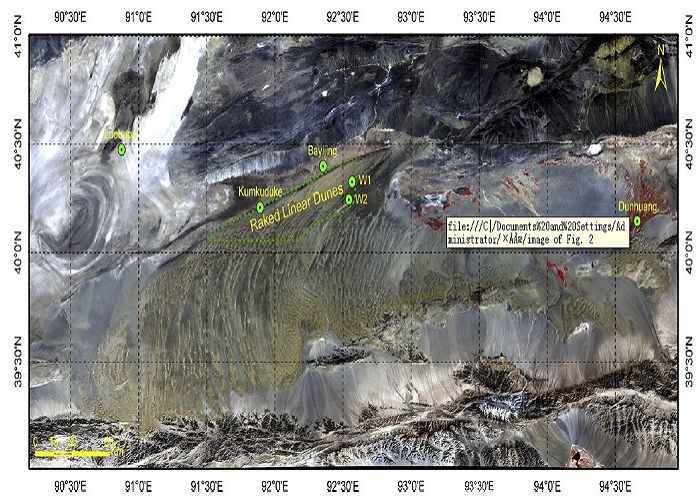“Raked” linear dunes in the Kumtagh Desert, China
Updatetime:2011-06-01From:
【Enlarge】【Reduce】

The location of the raked dune fields and wind towers (W1 and W2) in the present reaserch
The research of “Raked” linear dunes in the Kumtagh Desert, China was finished recently by the researchers of Cold and Arid Regions Environmental and Engineering Research Institute.
Linear dunes are extensive in sand seas and dune fields around the world, but they take a range of forms due to the complex factors that control their development. “Raked” linear dunes, composed of primary ridges and subsidiary ridges that lie almost perpendicular to the primary ridges, were recently identified in the northern part of China's Kumtagh Desert. The primary ridges are typical linear dunes, but the subsidiary ridges display vestiges of barchan dunes. The subsidiary ridges are sufficiently short that they do not greatly affect the general appearance of the linear dunes. However, the raked linear dunes in the Kumtagh Desert have several unique characteristics that distinguish them from typical linear dunes. These dunes develop in an environment that is deficient in available sediment, and under a wind regime typical of linear dunes: an environment with a high wind energy and a directional variability index (RDP/DP) around 0.5. The raked linear dunes appear to have evolved from barchans following a modified form of Tsoar's (1984) model.Barchans formed under a northern wind regime were modified by an eastern wind regime oriented at an oblique angle to the barchans. The strengths of the two wind regimes are similar. Under these conditions, the barchans became reoriented, with the limbs farthest from the eastern winds extending to form subsidiary ridges and the limbs closest to the eastern winds forming the primary ridges, which appear to form mainly from dune ollisions.
The research was subsidized by the National Science Foundation of China (40638038).
Appendix




